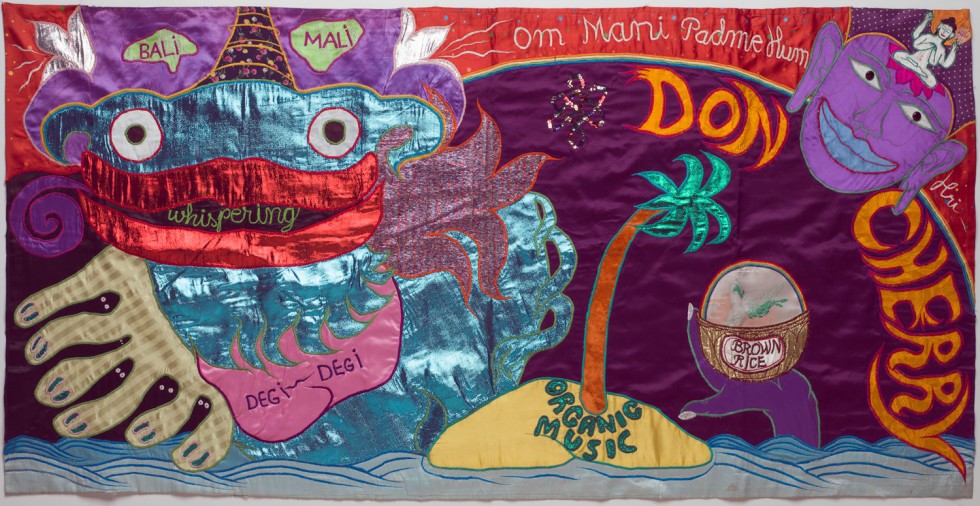Moment – Moki Cherry
07 Apr 2016 - 09 Apr 2017
MOMENT – MOKI CHERRY
7 April 2016 – 9 April 2017
Curator: Fredrik Liew
In Moki Cherry’s (1943–2009) multifaceted artistic practice, there are no sharp boundaries between design, art, drama and music. She was both typical of her age, and also found her own paths. In the notorious 1970s movement that emerged on the Stockholm art scene that launched rebellious attacks on “the establishment”, Moki Cherry stood out from the crowd. Rather than pointing out shortcomings, she wanted to present other ways of living. Her artistic practice was inspired by experiments such as counterurbanisation, subsistence-farming and children’s projects.
The exhibition Moment – Moki Cherry highlights the 1970s, but includes works made from 1967 to 2007. With a mixture of original works, documentation, music and stage photos, the ambition is to inscribe the objects in an itinerant narrative on the journey between life, art, pop, jazz, politics and Gesamtkunstwerk.
Moki and Don Cherry
In 1962, Moki Cherry moved from Skåne to Stockholm to study at the Beckmans College of Design. A few years later, she met the American jazz musician Don Cherry (1936–1995), and they embarked on a close collaboration. Separately and together, they created happenings, music, art, posters and album covers. Don and Moki toured and performed together, combining various forms of expression on stage in time and space. To describe their activities, they came up with the concept of Movement Incorporated in 1967, later changing the name to Organic Music.
The stage as a home and the home as a stage
In 1970, Moki and Don Cherry moved to an old school house in Tågarp, Skåne, where they lived according to the motto of “the stage as a home, and the home as a stage”. Tågarp eventually became a social hub that was almost like a commune at times. The following year, Moki and Don were engaged by Moderna Museet to run an open stage as part of its major exhibition Utopias & Visions 1871-1981. This project had its point of departure in the revolutionary government that ruled Paris in spring 1871, the Paris Commune. This collaboration was successful to the extent that when the exhibition’s curator, Pontus Hultén, was asked to start up Centre Pompidou in Paris, he invited them to run a temporary “Atelier des enfants” (children’s studio) while the institution was being built.
7 April 2016 – 9 April 2017
Curator: Fredrik Liew
In Moki Cherry’s (1943–2009) multifaceted artistic practice, there are no sharp boundaries between design, art, drama and music. She was both typical of her age, and also found her own paths. In the notorious 1970s movement that emerged on the Stockholm art scene that launched rebellious attacks on “the establishment”, Moki Cherry stood out from the crowd. Rather than pointing out shortcomings, she wanted to present other ways of living. Her artistic practice was inspired by experiments such as counterurbanisation, subsistence-farming and children’s projects.
The exhibition Moment – Moki Cherry highlights the 1970s, but includes works made from 1967 to 2007. With a mixture of original works, documentation, music and stage photos, the ambition is to inscribe the objects in an itinerant narrative on the journey between life, art, pop, jazz, politics and Gesamtkunstwerk.
Moki and Don Cherry
In 1962, Moki Cherry moved from Skåne to Stockholm to study at the Beckmans College of Design. A few years later, she met the American jazz musician Don Cherry (1936–1995), and they embarked on a close collaboration. Separately and together, they created happenings, music, art, posters and album covers. Don and Moki toured and performed together, combining various forms of expression on stage in time and space. To describe their activities, they came up with the concept of Movement Incorporated in 1967, later changing the name to Organic Music.
The stage as a home and the home as a stage
In 1970, Moki and Don Cherry moved to an old school house in Tågarp, Skåne, where they lived according to the motto of “the stage as a home, and the home as a stage”. Tågarp eventually became a social hub that was almost like a commune at times. The following year, Moki and Don were engaged by Moderna Museet to run an open stage as part of its major exhibition Utopias & Visions 1871-1981. This project had its point of departure in the revolutionary government that ruled Paris in spring 1871, the Paris Commune. This collaboration was successful to the extent that when the exhibition’s curator, Pontus Hultén, was asked to start up Centre Pompidou in Paris, he invited them to run a temporary “Atelier des enfants” (children’s studio) while the institution was being built.

